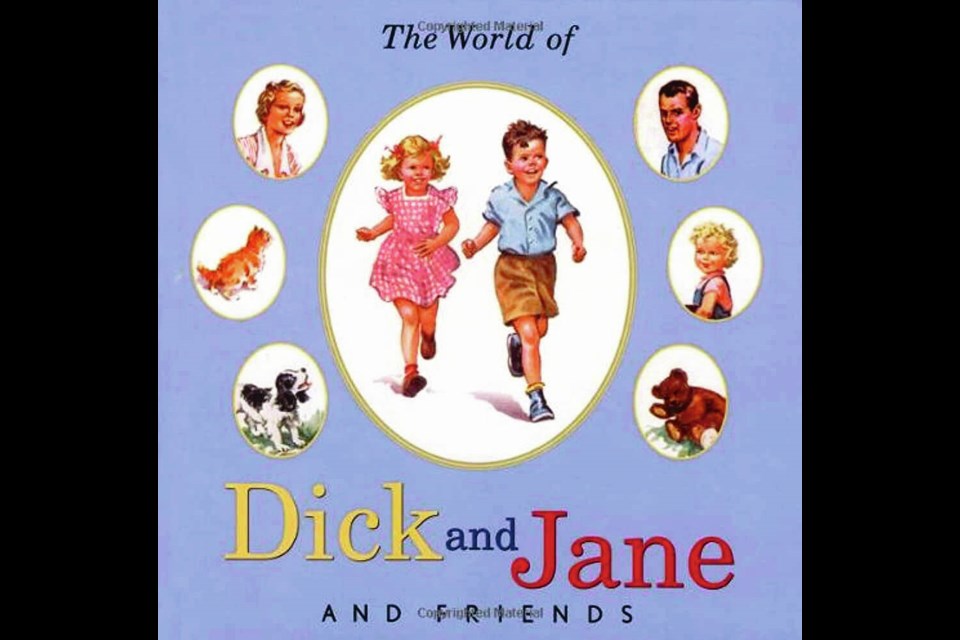The war over whether phonics or whole language is the best method of reading instruction has raged since the inception of universal public education in Canada in the late 1800s.
That could be at least partially due to the complexity of the English language, as well as a yearning on the part of some parents and even some teachers for “the way things used to be.”
The Dick and Jane readers that many parents remember fondly were an outgrowth of the anti-phonics movement of the middle twentieth century.
These popular readers were based on “new” (at the time) research on teaching and learning, and consisted of specially written stories with controlled vocabularies, in which words were repeated on each page enough times that students could remember them.
This became referred to as the Whole Language Reading Theory, which emphasized the meaning of texts more than the phonics approach, which emphasized learning the sounds of letters.
However, by the 1950s, phonics again began to increase in popularity due to the number of students who had difficulty with the “look/say” approach used in the Dick and Jane reading series.
Then in the early 1980, many early childhood educators adopted the “whole language” philosophy of teaching reading, which emphasizes identifying words using literary context.
As with other debates about “best way” teaching methods, the literacy-based “whole language” approach to teaching could not be reconciled with the phonics focus on individual sounds of letters and letter combinations.
That’s too bad, because the debate over which is the better method of teaching reading is non-productive and ignores the benefit of seeking value in aspects of both methods as they apply to individual children’s learning needs.
Dr. Jennifer Buckingham, senior research fellow at MultiLit, which provides literacy instruction in Australia, has provided evidence-based information on effective reading instruction for struggling readers to the NSW, Victorian, South Australian and federal governments.
Buckingham says reading is the most researched aspect of education, and the strongest and most consistent evidence supports “explicit and systematic instruction in phonics, especially an approach that involves cumulatively teaching letters and sounds and how to decode words.”
So far, so good, but Buckingham also recognizes that some words in English — like yacht, island, right, enough, does, goes and sign — don’t follow the rules of phonics and can’t be “sounded out.”
They need to be memorized, usually in context so they’re instantly recognizable. “Phonics is essential but not sufficient”, she says. “It must be taught early and well, but always alongside vocabulary and comprehension,” which is the basis for the “whole language” approach.
All of which begs the question: While all this squabbling about the best way to teach reading continues, what is happening to Canadian children’s literacy rates?
The answer is discouraging. A 2020 Economic Overview of Children’s Literacy in Canada, which Deloitte prepared for the Canadian Children’s Literacy Foundation, found that one million Canadian children under the age of 15 are estimated to have below grade-level literacy skills.
That’s about one in eight kids. And the percentage of 15-year-olds with the lowest levels of literacy has increased over the past decade.
The report also paints a compelling picture of why investing in early literacy is the cornerstone of children’s health, education, future employment and income, and why it is critical for the future of Canada.
Deloitte’s analysis shows that about 25 per cent of Canadian children can’t read at grade level by Grade 3. These are the children who are most likely to struggle in all school subjects because they don’t have the strong reading skills they need to be successful students.
The well-researched B.C. Primary Program (for kindergarten to Grade 3) wisely avoids the non-productive how-to-teach -reading debate with the following Solomon-like statements: “Phonics instruction needs to be properly timed. It should be part of the second stage of literacy learning — accuracy — not seen as the first strategy for teaching children to read.”
It adds that “reading is a construction of meaning from written text, it is an active, cognitive, and affective process. Environments rich in literacy experiences, resources, and models facilitate reading development.”
Geoff Johnson is a former superintendent of schools
>>> To comment on this article, write a letter to the editor: [email protected]



